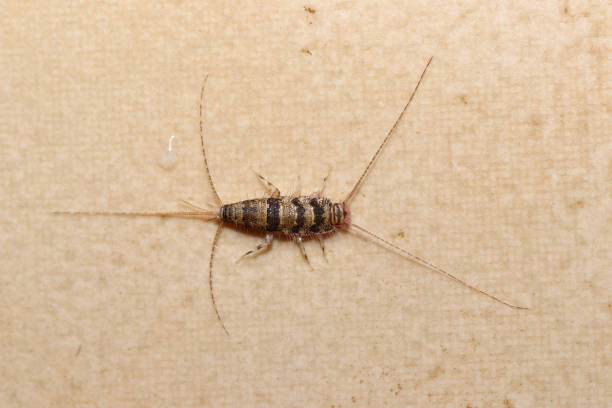Behaviour, Diet, Habitat and Life CycleSilverfish are scavengers that will eat almost anything they can find. They prefer carbohydrates and proteins, such as flour, sugar, starch, paper, glue, cotton, linen, silk, dried meat, cereal, and book bindings. They also eat fungi, algae, dead insects, and their own molted exoskeletons. They can survive without food for up to a year, but they need high humidity and moisture to live.
They are adaptable and can live in a wide range of habitats. They normally live outdoors under rocks, bark, leaf mold, in the nests of birds and mammals, and in ant and termite nests. However, they can also invade houses and buildings, where they are considered pests. They are attracted to dark, damp, and cool places, such as basements, bathrooms, kitchens, attics, closets, and storage areas. They can enter through cracks, crevices, pipes, vents, or windows. They are active throughout the year and can tolerate temperatures from 0 to 40 C, but they prefer 21 to 27 C.
Silverfish have a long life span, ranging from two to eight years. They undergo incomplete metamorphosis, meaning they do not change their form as they grow. They molt several times throughout their life, sometimes up to 50 times. They are sexually mature after three to 24 months, depending on the species and environmental conditions. They have a complex mating ritual, which involves the male depositing a sperm capsule that the female picks up with her genital opening. The female then lays eggs, usually in small groups of one to 50, in cracks and crevices. The eggs hatch in two to eight weeks, and the nymphs look like miniature adults. They reach adulthood in three to 24 months.
Why Do I Have Silverfish in My House ?Some of the reasons why you might have silverfish in your home are:
Moisture: Silverfish need high humidity and moisture to survive. They can thrive in damp areas, such as basements, bathrooms, kitchens, laundry rooms, or crawl spaces. They can also be attracted to water leaks, condensation, or poor ventilation.
Food: Silverfish feed on various organic materials, especially those containing starch, sugar, or protein. They can eat flour, sugar, starch, paper, glue, cotton, linen, silk, dried meat, cereal, and book bindings. They can also eat fungi, algae, dead insects, and their own molted exoskeletons. They can contaminate your food and damage your belongings with their feeding marks, stains, holes, or notches.
Shelter: Silverfish like to hide in dark, secluded, and undisturbed places, where they can avoid predators and light. They can be found in cracks, crevices, wall voids, behind baseboards, under carpets, in bookcases, in closets, or in attics. They are active at night and can move quickly and jump when disturbed.
How to Prevent Silverfish in My House ?To prevent silverfish from infesting your home, you can take some of the following steps:
Reduce moisture: Fix any water leaks, improve ventilation, use dehumidifiers, or fans to lower the humidity and moisture levels in your home. Keep your bathroom and kitchen dry and clean, and wipe off any condensation on windows or pipes.
Eliminate food sources: Store your food in airtight containers, and keep your pantry and kitchen cabinets clean and organized. Dispose of any spoiled or infested food, and clean up any crumbs or spills. Vacuum your carpets, rugs, and furniture regularly, and wash your linens and clothes in hot water. Remove any clutter, such as cardboard boxes, papers, books, or magazines, that can provide food and shelter for silverfish.
Seal entry points: Caulk or seal any cracks, crevices, gaps, or holes in your walls, floors, ceilings, doors, or windows, where silverfish can enter or hide. Use screens, mesh, or weather stripping to cover any openings, such as vents, pipes, or drains. Inspect any items that you bring into your home, such as books, furniture, or clothing, for signs of silverfish or their eggs.
If you have a severe or persistent infestation of silverfish, you may need to contact a professional exterminator, who can use various methods, such as pesticides, diatomaceous earth, or fumigation, to get rid of them.
How Do Exterminators Get Rid of Silverfish ?Exterminators use various methods to get rid of silverfish, depending on the extent and location of the infestation. Some of the common methods include:
Pesticide application: Exterminators may apply pesticides, such as pyrethrins, pyrethroids, or borates, to targeted areas where silverfish are found or suspected. These pesticides kill silverfish on contact or by ingestion, and may also have a residual effect that prevents reinfestation. Exterminators may use sprays, dusts, granules, or baits to apply the pesticides.
When to call a silverfish exterminator ?The best is to call us as soon as possible. We service the Greater Toronto Area, call us now 647 849 4441
Call us today to speak with our silverfish exterminator
GTA Exterminators for silverfish removal in Toronto
Call us today for silverfish extermination


